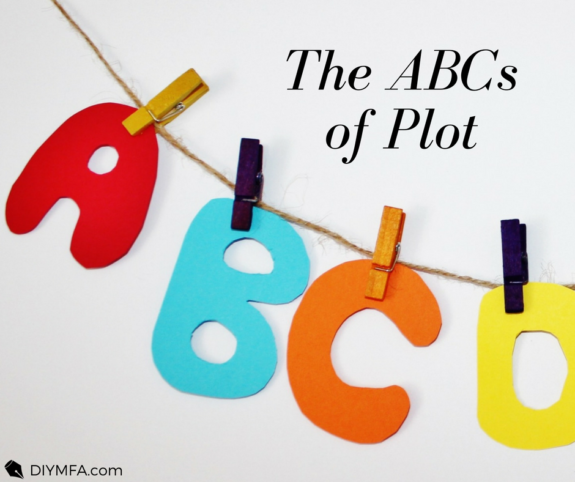The ABCs of plot is a technique I learned from one of my mentors and it’s very powerful for helping writers map out the plot of their stories. I’ve since borrowed parts of the method, added some of my own flare and have used it in many of the workshops I teach. You can use this ABC method to outline just about any piece of fiction, from a novel to a short story, to a synopsis to a pitch. The reason this method works is because it makes sure you hit all the important landmarks in the story. And it’s easy to remember because all you need are your ABCs.
A is for Action:
Every story starts with some sort of action or event. The technical term for this is inciting incident but really that’s just a fancy way of saying that something has to happen to set your story in motion.
B is for Background:
At some point early in the story, we need to get a little bit of background on who the characters are and why we should care about them. Just be careful not to go so over-the-top with your background that it keeps you from getting to the main part of the story. As is the case with most back-story, less is more.
C is for Conflict:
Sooner or later (usually sooner is better) you have to introduce the conflict of the story. What does the protagonist want more than anything else? What’s standing in his or her way? It’s the tension between the character wanting something but having obstacles in his/her way that creates conflict. Sometimes your character can even have more than one “want” which can lead to lots of different levels of conflict, making for a deliciously fascinating story.
D is for Development:
This is that middle section of the story–Act II, as it were–where most of the story unfolds and important events happen but you haven’t quite reached the final showdown just yet. I find that the best way to plot out the D section is to use the rule of 3. Most stories boil down to three main events that lead up to that final showdown; these events often build on each other, the tension increasing with each one.
E is for Ending:
You’ve reached the final showdown! But wait, the ending is actually made up of 3 subsections (the 3 C’s: Crisis, Climax and Consequences).
- Crisis refers to the moments leading up to that final showdown.
- Climax is the big showdown, that important scene where the tension reaches its peak.
- Consequences is often called “denouement,” which is just a fancy word for what happens after the climax.
Let’s put this into action:
Using one of my favorite examples, The Wizard of Oz, let’s look at how the ABC method can help us map out the basics of the story.
Act I:
A tornado carries Dorothy’s house away from the Kansas farm where she lives and drops both Dorothy “and her little dog too” in the magical land of Oz (A). We learn early in the story that Dorothy has been longing to leave Kansas and go “somewhere over the rainbow.” Before the tornado, she had run away from home which caused her to get caught in the storm. (B). Of course, when Dorothy gets to OZ she realizes all she wants is to go back home after all. We also learn that her house accidentally killed the Wicked Witch of the East and now the Wicked Witch of the West is out to get Dorothy (C). Notice how we have two conflicts here: Dorothy’s inner conflict of wanting to go home and the external conflict between Dorothy and the Wicked Witch.
Act II:
Dorothy learns that the only way to get home is to ask the Wizard for help so she follows the yellow brick road to the Emerald City. On the way she meets a Scarecrow who wishes for a brain, a Tin Man who longs for a heart and a Cowardly Lion who wants courage (note the rule of 3 in action here). When Dorothy and her friends reach the Emerald city and speak to the wizard, they discover that to get what they want, they must get rid of the Wicked Witch of the West (D).
Notice how we have the Rule of 3 working on a couple of levels in the story:
- Three friends Dorothy makes on her journey.
- Three times the Wicked Witch causes trouble for her (first in munchkin land, then in the poppy field, then finally at the Witch’s castle).
Act III:
Dorothy and her friends try to track down the Wicked Witch, but Dorothy and Toto get captured (Crisis). Dorothy’s friends come to rescue her and must face the witch. In the face-off, Dorothy splashes the witch with a bucket of water, causing her to melt (Climax).
The triumphant group returns to the Wizard only to discover that the wizard is not all-powerful. In fact, the wizard tells the friends that they already had the things they longed for all along. After a botched attempt to return home in a hot-air balloon, Dorothy learns from the Good Witch Glinda that she had the power to go home all along. Dorothy just needs to click her heels together three times and say “There’s no place like home” (Consequences).







